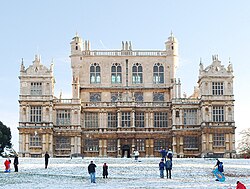| Wollaton Hall | |
|---|---|
 Wollaton Hall in the snow, November 2010 | |
| Type | Prodigy house |
| Location | Nottingham, Nottinghamshire |
| Coordinates | 52°56′53″N 1°12′35″W / 52.9480°N 1.2096°W |
| Built | 1580-1588 |
| Built for | Sir Francis Willoughby |
| Architect | Robert Smythson |
| Architectural style(s) | Elizabethan |
| Owner | Nottingham City Council |
| Website | wollatonhall.org.uk |
Listed Building – Grade I | |
| Official name | Wollaton Hall |
| Designated | 11 August 1952 |
| Reference no. | 1255269 |
Listed Building – Grade II* | |
| Official name | Camellia House 100 Metres South West of Wollaton Hall |
| Designated | 12 July 1972 |
| Reference no. | 1255271 |
Listed Building – Grade II* | |
| Official name | Doric Temple and Attached Bridge 200 Metres South-East of Wollaton Hall |
| Designated | 10 August 1989 |
| Reference no. | 1270389 |
| Official name | Wollaton Hall |
| Designated | 1 January 1986 |
| Reference no. | 1000344 |

Wollaton Hall is an Elizabethan country house of the 1580s standing on a small but prominent hill in Wollaton Park, Nottingham, England. The house is now Nottingham Natural History Museum, with Nottingham Industrial Museum in the outbuildings. The surrounding parkland has a herd of deer, and is regularly used for large-scale outdoor events such as rock concerts, sporting events and festivals.
